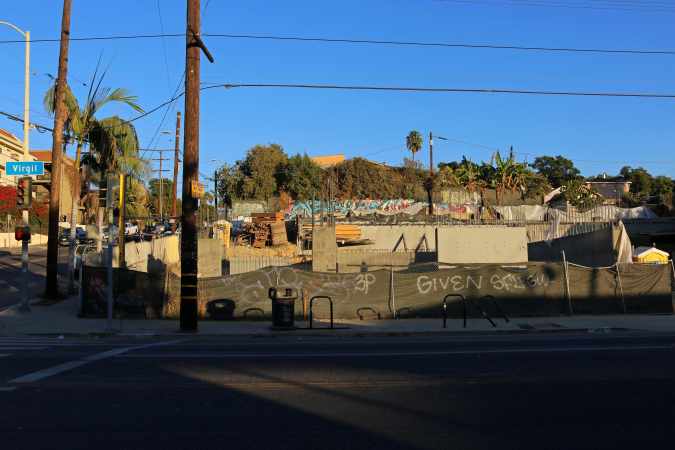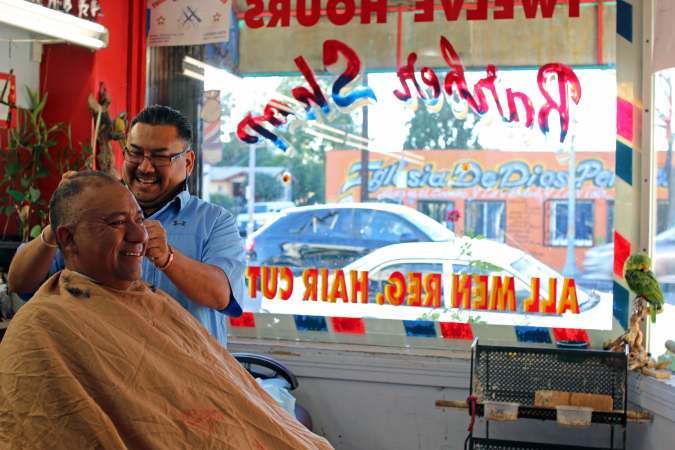First, a Korean-owned grocery store closed its doors. Then, a Mexican-owned furniture and antique store became a high-end vintage boutique. Later, a gelato shop popped up. Then, from one night to the other, Cha Cha Cha, a 30-year-old neighborhood staple known for its eccentric décor and Caribbean-fusion cuisine, shuttered. Months later, not a trace of its kitschy décor was left, instead replaced by mounds of dirt from the tractors that demolished its walls, its history, and its memories to make way for luxury apartments.
Soon enough, it was the building I lived in. A letter arrived letting us know we had to leave. One by one, families who had been there for 15, 20, even 40 years were displaced. Whole lifetimes, births and deaths, forgotten.

I was lucky to find a place across the street. I looked out my window and witnessed each of the spaces once filled by Latinx families replaced by white faces, twinkly lights, and succulents.
Virgil Village is a neighborhood within a neighborhood in East Hollywood, Los Angeles. The trumpet tree-lined street of Virgil Avenue is its main artery. Here, a historically Central American population who fled civil wars in the ’80s has created a vibrant community. There are multiple Pentecostal churches providing a space of worship for the Salvadorans. There’s a Guatemalan bakery, a Salvadoran restaurant, two carnicerias, and one liquor store, among other small businesses. Parallel to Virgil Avenue is Hoover Street, the border between East Hollywood and Silver Lake, a now famous neighborhood with the usual signs of gentrification: unaffordable housing, third-wave coffee shops, expensive boutiques, gourmet vegan restaurants, and cocktail bars.
Los Angeles has a penchant for erasing its past, building over histories as if they never existed.
It was only a matter of time before the gentrification bled across Hoover Street and into Virgil Village.
Los Angeles has a penchant for erasing its past, building over histories as if they never existed. Would anyone remember Cha Cha Cha once the luxury apartments were built? Would anyone remember Elvia, the Guatemalan woman who owns a bakery catering to the tastes of fellow Central Americans? Would anyone remember the hard work of Sandra, who manages the Salvadoran restaurant that provides the comfort of home to immigrants forced to flee their country? Would anyone remember Pablo, the Yucatecan man who’s lived here for 25 years and taught his children his native Mayan language as a way to preserve his Indigenous culture? Or what about Felix, the barber known for this his parrots perched outside of his shop, an ode to his Guatemalan grandmother who owned birds back in her home country?
When I saw the swift erasure of the neighborhood, I realized I could use my resources – in this case, a camera, my iPhone, and my connection to the community – to make sure people’s stories are told. That’s when I started This Side of Hoover on Instagram as a way to visually trace the changing landscape and record the legacies of the people who’ve made Virgil Village their home and place of work. People told me of football games played between neighbors on parallel streets, of Yucatecan block parties that stopped happening due to displacement and noise complaints, and of a person who bought their neighbor’s home for safeguarding in the 1940s because the family was being sent to a Japanese internment camp. The documentation highlights countless memories of historical and personal significance underscored by people’s experience with the displacement of loved ones and fears for the future of the place they call home.
Archiving on social media allowed me create a participatory platform where people share their stories of Virgil Village in a way that’s community oriented and accessible. We reconstruct the history of the neighborhood together.

Instagram has become a place where we can create digital archives as a way to showcase Latinx contributions and rewrite history in a way that’s representative of our complex reality and diverse identities. I was inspired by the work of Guadalupe Rosales who created Veteranas and Rucas and Map Pointz as a way shift the narrative and record the experiences of Latinx youth cultures in Southern California. Other accounts are doing similar work like Rock Archivo LA’s documentation of Latinx participation in the Los Angeles Rock En Espanol scene and Firme Hinas’ visual celebration of homegirls in 1990s Los Angeles.
Through these accounts we have a way to represent ourselves and create far-reaching public archives.
While gentrification is a contentious topic, I hope this Instagram account can humanize the experience. But most importantly, This Side of Hoover allows me to center the stories of the places and people who made Virgil Village a vibrant and complex neighborhood to begin with and in turn show what we lose when we erase history and displace communities.
Editor’s Note: Samanta Helou, the author of this piece, will join Rock Archivo LA’s Jorge N. Leal (Rock Archivo LA), Guadalupe Rosales (Map Pointz), and Alejandra Olmedo (A Certain Girl Zine) for Arts+Culture past, present, future, a panel at the Los Angeles Times Festival of Books. The panel seeks to learn how archival literature helps us revisit, reframe, and reshape the conversation about identity and the Latinx community. The event will take place on Sunday at 3:30 p.m. at the University of Southern California. Learn more here.




